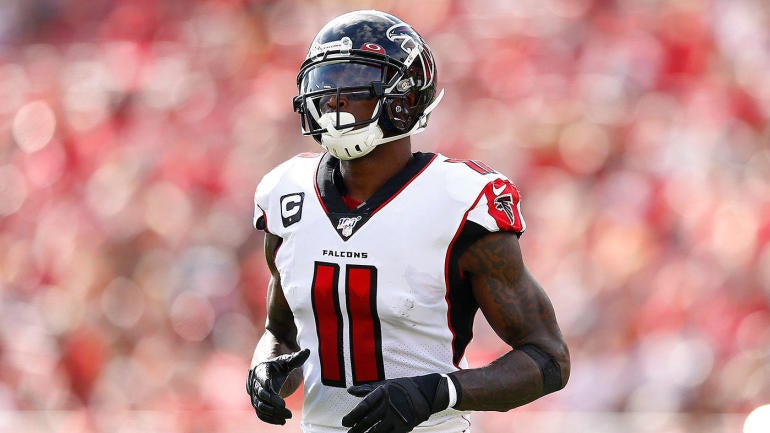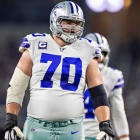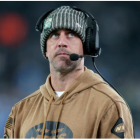
The cat is out of the bag. The Falcons have been listening to offers for wide receiver Julio Jones because he reportedly requested a trade in March. When asked about his future in Atlanta during a phone call with Fox Sports 1's "Undisputed" co-host Shannon Sharpe on Monday -- that Jones apparently didn't know was live on air -- he said, "I'm out of there."
A primary motivation for Atlanta contemplating a trade, besides the seven-time Pro Bowler requesting a change of scenery, is an extremely tight salary cap. The Falcons only have $358,694 of cap space, according to NFLPA data. This is why none of the nine players the Falcons selected in the 2021 NFL Draft have been signed. The collective first-year or 2021 cap numbers for the draftees will be $13,048,199 once under contract. The net effect on Atlanta's salary cap will be a $6,224,912 change because of offseason accounting where only the top 51 salaries (i.e., cap numbers) matter.
Jones signed an extremely front-loaded three-year, $66 million contract extension in 2019 that put him under contract for five years at the time since he had two years remaining on his existing deal. He has $38.326 million in the three years left on his contract. There is a $3 million base salary escalator in each of the last two years of the contract (2022 and 2023) based on Jones' performance in preceding seasons.
Jones is scheduled to make a fully-guaranteed $15.3 million base salary this year. His 2022 and 2023 salaries are each $11.513 million. $2 million of Jones' 2022 base salary is also fully guaranteed.
Want inside access into the NFL from an active player and conversations with prominent guests? Download and subscribe to All Things Covered with Patrick Peterson and Bryant McFadden as the duo share their thoughts on Julio Jones.
A trade wouldn't take place before June 2. Under salary cap rules, bonus proration from future contract years doesn't accelerate into the current year when players are traded or released after June 1. Jones' extension contained a $25 million signing bonus being prorated annually at $5 million and an $11 million option bonus that's prorated at $2.75 million for 2020 through 2023. Trading Jones -- who has a $23.05 million 2021 cap number -- prior to June 2 would result in a $200,000 increase in Atlanta's salary cap because the Falcons would be left with a $23.25 million cap charge from the bonus proration in these three remaining years.
By waiting until June 2, the Falcons would pick up $15.3 million of 2021 cap space where the cap charge relating to Jones this year would be his $7.75 million of 2021 bonus proration. Atlanta would have a $15.5 million cap charge next year because of the 2022 and 2023 bonus proration.
These dynamics haven't put the Falcons in fire-sale mode where Jones will just be given away. The 32-year-old Jones is coming off one of his worst statistical seasons. Limited to nine games in 2020 primarily because of lingering hamstring problems, Jones had 51 catches for 771 yards and three touchdowns. His six-year streak of 1,000-receiving-yard seasons was snapped.
Nonetheless, Jones still ranked seventh in the NFL with 85.7 receiving yards per game, which was his worst mark since 2012.
The Falcons want a first-round pick for Jones. According to Pro Football Talk, the Falcons could have gotten a second-round pick, presumably in 2022, for Jones prior to the draft in a trade that would have been finalized after June 1 because of salary cap reasons. Although general manager Terry Fontenot and head coach Arthur Smith are new, owner Arthur Blank may have a hard time reconciling that the trade compensation for Jones would be comparable to the second-round pick received for wide receiver Mohamed Sanu, who was dealt to the Patriots during the middle of the 2019 season.
A solution could be a conditional 2022 second-round pick that becomes a first-round pick if Jones makes the Pro Bowl on the original ballot in 2021 or reaches certain statistical marks. For example, the average production of the 2018 through 2020 Pro Bowl wide receivers (original ballot) is 100 catches and just under 1,325 receiving yards. These numbers are consistent with the single-season thresholds of 100 receptions and 1,400 receiving yards that trigger Jones' escalator. To make it more interesting, the Falcons would only receive a third-round pick if Jones' 2021 production falls short of the 51 catches for 771 yards he had in 2020.
A team must have enough salary cap room to absorb a player's current salary in order to make a trade. Only about one-quarter of NFL teams can currently accommodate Jones' $15.3 million salary based on NFLPA data. Those teams are below.
| Team | Salary Cap Room (as of May 26) |
|---|---|
$39,495,829 | |
$24,665,845 | |
$23,211,086 | |
$22,658,920 | |
$21,037,323 | |
$20,580,774 | |
$19,463,966 | |
$18,393,054 | |
$17,667,994 |
Only the 49ers are Chargers are among the teams with the best odds to acquire Jones, according to SportsLine.
Via SportsLine oddsmakers: Julio Jones' next team (if traded)
— SportsLine (@SportsLine) May 24, 2021
49ers +250
Raiders +300
Patriots +500
Chargers +700
Titans +800
Ravens +900
Colts +1200
Packers +1500https://t.co/fgFZtU7JAP
Need a quick betting primer on your favorite NFL team for the 2021 season? Here are links to schedule breakdowns for all 32 clubs.
The Patriots and Titans, who are reportedly on Jones' radar screen, have $15,017,432 and $3,903,332 of cap room, respectively. The Raiders, who have the second-best odds, are $4,010,569 under the cap after signing 2021 first-round pick Alex Leatherwood. The sixth-best odds belong to the Ravens who have $9,384,911 of cap space.
The Falcons likely don't feel that converting a portion of Jones' 2021 salary into signing bonus before a trade to lessen the cap hit for the acquiring team -- like the Panthers did with quarterback Teddy Bridgewater -- is warranted given their own cap problems. Obviously, teams could create cap room by restructuring contracts in order to be in position to handle Jones' 2021 salary.
An alternative would be to borrow a concept from linebacker Kiko Alonso's 2019 trade from the Dolphins to the Saints at the preseason roster cutdown. Prior to being dealt, Alonso agreed to move a small portion of his 2019 base salary into a fifth day of the 2020 roster bonus that became fully guaranteed five days after the trade.
For example, shifting $5.3 million of Jones' 2021 base salary into the first day of the 2022 league year roster bonus that's fully guaranteed within several days of a trade to the Patriots would mean New England would only use $10 million of existing cap space to get him. Jones' 2022 compensation would become $16.513 million.
Additionally, Alonso took a small salary reduction in 2019 and the Dolphins ate $1 million in a pre-trade salary conversion. It's hard to imagine Jones taking a pay cut to facilitate a trade considering he would be a good value for an acquiring team at less than $13 million per year over the next three seasons if he can regain some semblance of his previous form despite his age.
Should Jones agree to move money into next year to get out of Atlanta, any guaranteed March roster bonus in 2022 would need to have no offsets so he wouldn't be in a worse position than leaving his contract alone. In the event he was released, he would get to double dip where he would earn the entire roster bonus and his salary with his new team instead of the acquiring team getting to recoup the guarantee from his next contract elsewhere.
Jones is currently eligible to receive the additional payment for the 17th game because his contract predates the NFLPA and NFL agreeing to the extended regular season. Since Jones would no longer qualify for the extra game check after this type of contract modification, roster bonuses of $900,000, $677,235 and $677,235 for being on the 90-man roster for the 17th game would need to be added to 2021, 2022 and 2023, respectively, so he wouldn't be penalized financially by the change.
An extremely soft trade market may make keeping Jones in 2021 something for the Falcons to consider. The Falcons would want to find cap relief elsewhere -- although Jones has the NFL's largest 2021 cap number for a wide receiver if he is kept. Any contract restructure creating 2021 cap room would add to the bonus proration in 2022 and 2023 and the dead money, a salary cap charge for a player no longer on a team's roster, when he is eventually traded.
Pro Bowl defensive tackle Grady Jarrett is the most logical source for cap space in the event Jones isn't dealt. His $20,833,333 2021 cap number is the second-largest among defensive tackles. The four-year, $68 million contract he signed in 2019 as a franchise player has two years remaining. $10 million of 2021 cap room can be gained by converting $12.5 million of Jarrett's $13.5 million 2021 base salary into signing bonus while adding three dummy/voiding contract years for 2023 through 2025. The $12.5 million signing bonus would be prorated over five years instead through 2022 with the fake years.
Giving Jarrett a three- or four-year extension is another possibility. An extension would surely be over $20 million per year. The Giants signed Leonard Williams, who was franchised for a second straight year as a defensive tackle, to a three-year, $63 million contract with $45 million fully guaranteed in March. Lowering Jarrett's 2021 base salary to $1 million while giving him a $20 million signing bonus would yield $1.5 million less in 2021 cap room for the Falcons than the suggested contract restructure.

















